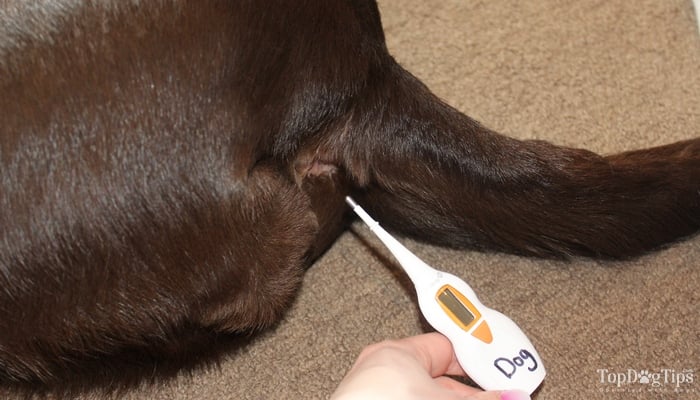Our dogs can't tell us when their feeling feverish or if their heart is racing. Oftentimes, owners don't even realize their dog is ill until it's too late for treatment. Learning how to check a dog's vital signs is important to know to prevent a health emergency.
Table of Contents
Dog CPR Essentials for Owners
Canine CPR is an essential part of dog ownership. The time to learn these simple steps is not when your dog already seems to be having trouble breathing or otherwise seems unwell. Owners should know how to check a dogs vital signs and practice occasionally.
For example, I always recommend owners get a pet first aid kit where they can store not only the essential supplies, but other dog health related stuff. Personally, I keep a small notebook in our pet first aid kit to record my dog's vital signs at least once per month. I used to do it weekly when I was first learning CPR for dogs.
The three important dog's vital signs that you need to know how to check are:
- Heart rate
- Breathing rate
- Temperature
If you keep a log of your pet's vital signs, you can memorize what the dog's average heart rate, breathing rate and temperature are, and then compare them during monthly check-ups. All dogs are different and their vital signs will not always be the same.
Supplies You Need for Checking Vital Signs in Dogs
As I've mentioned, it's important to always have a dog first aid kit in your home for those unprecedented times. However, most of them will not contain some of the essentials for checking a dog's vital signs, so here are the five items that you need for this.
| Preview | Product | Rating | |
|---|---|---|---|

|
IPROVEN® Rectal and Oral Digital Thermometer for... | 13,905 Reviews | Check Price |

|
Vaseline Pure Petroleum Jelly, Original 16.23 Oz -... | 3,619 Reviews | Check Price |

|
MDF Instruments, Acoustica Lightweight Stethoscope... | 36,164 Reviews | Check Price |

|
Pet Emergency Pocket Guide | 322 Reviews | Check Price |

|
RC Pet Products Pet First Aid Kit | 346 Reviews | Check Price |
While some expensive pet first aid kits will include most of these items, it's cheaper to buy a simple kit and add the essential items separately. Moreover, things like petroleum jelly will not be found in any kits, but they're very helpful not only for checking a dog's temperature but for many other dog care related practices.
How to Check a Dog's Vital Signs
1. How to Check a Dog's Heart Rate
The average heart beat for a dog is between 60-140 beats per minute. There is a large variance because dogs greatly vary in sizes. For example, small breeds should have an average heart beat of 100-140 and for large breeds, it averages about 60-100.
Generally, you should not worry until a dog's heart rate drops below 60 or jumps up above 140 heart beats per minute. However, it's important to confirm this with a vet. I explain this in more details in my dog heartbeat guide.
Here's how to do this:
Locate. You should be able to feel your dog's heart beating in his chest without using a stethoscope. Simply lift your dog's left front paw. See where the “armpit” is located? Place your hand in that area and move it around slightly until you feel your dog's heart beating.
Count. To figure out a dog's heart rate, you'll need a clock or watch with a seconds hand, or a stopwatch. Most smartphones have timer apps that you can download for free. Now, simply count the number of times a dog's heart beats in a 15 second period of time.
Calculate. Let's say your dog's heart beats 20 times in 15 seconds. Multiply that heart rate by 4 to find the number of times that the dog's heart beats in a minute. In our example, you would multiple 20 by 4, which is 80. This means the dog's heart rate would be 80 beats per minute, which is well inside the “normal” range – nothing to worry about.
Note: Make sure you're learning how to check your dog's vital signs when your pet is relaxed. If you try to check for vital signs right after a dog has been running or hiking, it's going to skew the results; all of the dog's vital signs will be elevated after exercise.
2. How to Check a Dog's Breathing Rate
Don't put your stopwatch away just yet. You're going to need it for the next steps of checking other dog vital signs, including your dog's breathing rate.
This one is very similar to calculating your pet's heart rate. As I mentioned, you'll want to do this when your dog is resting. Try to get your pooch to lie on his side, like I did with Saddie in the above picture.
Feel the chest. With a resting and calm dog in front of you, place your hand on your pup's chest. You should be able to see the dog's chest expand every time he takes a breath in.
Count breaths. You're going to need to count the number of breaths the dog takes in a 15 second period of time. Then you'll use this number to do the same math we did above to find a dog's breathing rate in a minute.
Do the math. Normally, dogs usually take about 12-24 breaths per minute. So let's say that you counted 5 breaths in the 15 seconds that you were watching your dog breathe. Multiply 5 by 4 to find your dog's breathing rate per minute. 4 multiplied by 5 is 20, which is right in the middle of the range for a “normal” breathing rate – not to worry here.
3. How to Check a Dog's Temperature
First, remember that a dog's temperature runs slightly hotter than a humans. This is normal, so do not be expecting a 98.6° temperature from your dog. Furthermore, large breeds generally have lower body temperatures than small breeds (for unknown reasons).
The average dog's temperature should be between 100.5° and 102.5°.
Now, if the picture above makes you cringe, you're not going to like this final step on how to check a dog's vital signs, but it's still important and you should know how to do this.
While it's somewhat possible to take a dog's temperature without a thermometer, that reading is not going to be accurate. The only accurate way to get your dog's temperature is by using a rectal thermometer, as I've demonstrated in more details here.
Note: You don't need to purchase any special thermometers for dogs. While pet thermometers do exist, any simple digital thermometer (for humans) will work just as well. However, be sure to label it “For Dog” like I did, or someone in your home may make the mistake of using it on a person.
Here's how to do this:
- Coat the end of the thermometer with petroleum jelly and insert about 1 inch into your dog's rectum.
- Turn the thermometer on and wait for it to take an accurate reading. Most thermometers will beep when they're finished.
- Once you've removed the thermometer, it's important that you thoroughly clean it. Wipe off the petroleum jelly and wash the thermometer with hot water and soap.
And now you're done! These three methods for taking a dog's vital signs give you three very important readings that will indicate if your pooch is ever in poor health.
READ NEXT: How to Do CPR On a Dog
Disclosure: We may earn affiliate commissions at no cost to you from the links on this page. This did not affect our assessment of products. Read more here and find full disclosure here.
















